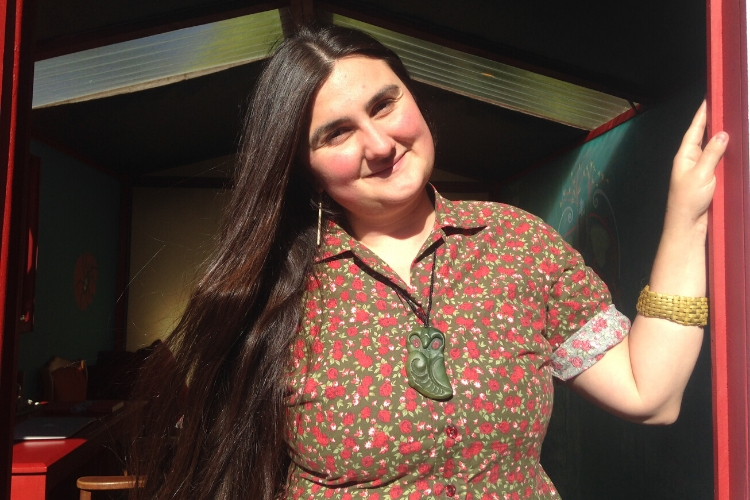In our Composer Spaces series, we ask composers to share a bit about their working environment and to give us a brief insight into their process. This week we present composer, Ruby Solly.
Please list any iwi | tribal | nation affiliations:
Kai Tahu / Waitaha / Kāti Māmoe
Please tell us about your composition and writing process, and what inspires you when composing?
I’ve got a massive interest into how the environment acts as a player within music at the moment, and often find inspiration from mimicking and responding to sounds from around me. I like to think too about how those sounds are in turn effected by us, like how tūī now mimic car horns or non-native birds, and how we mimic their sounds as bird songs, which ties into how human speech was learnt from bird song in te ao Māori. I love thinking about how all these things loop around and try to play with where in those loops I sit and compose from. I think a lot about the concept of history and how that exists as whakapapa as well. I’ve been working on a project recently where I was able to write some music that reflected my connection to the land I live on and the ancestors that passed through here (Pōneke) on their way down south.
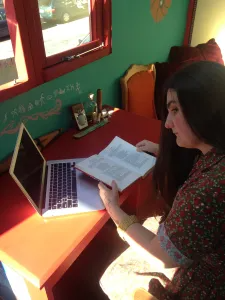 Ruby sitting at her desk with her laptop and taonga.
Ruby sitting at her desk with her laptop and taonga.
Please describe the space where you compose your music, what makes it unique, and why have you chosen it?
I’m really lucky to have a shed that we built on top of our garage (thanks to the consent of the best land lords on the planet!). It’s called ’Te Whare Whakaaro’ which is a pun on a house for thinking, but also a house of actioning ‘Aro’ as we live in Aro Valley and are super proud valleyites. I’ve got no power in there at the moment, so use rechargeable lights and battery packs for laptops etc, then do recording in the spare room when I need to. I try keep the space fairly neutral as I use it for writing work as well, and then I just bring in things I’m using for each project. Sometimes that’s taonga Puoro, sometimes cello, sometimes just recording stuff. It all depends really! I think the best thing about the space for my process is having giant blackboards (well, actually blue boards) on two of the walls that I can write plans out on, or draw things out.
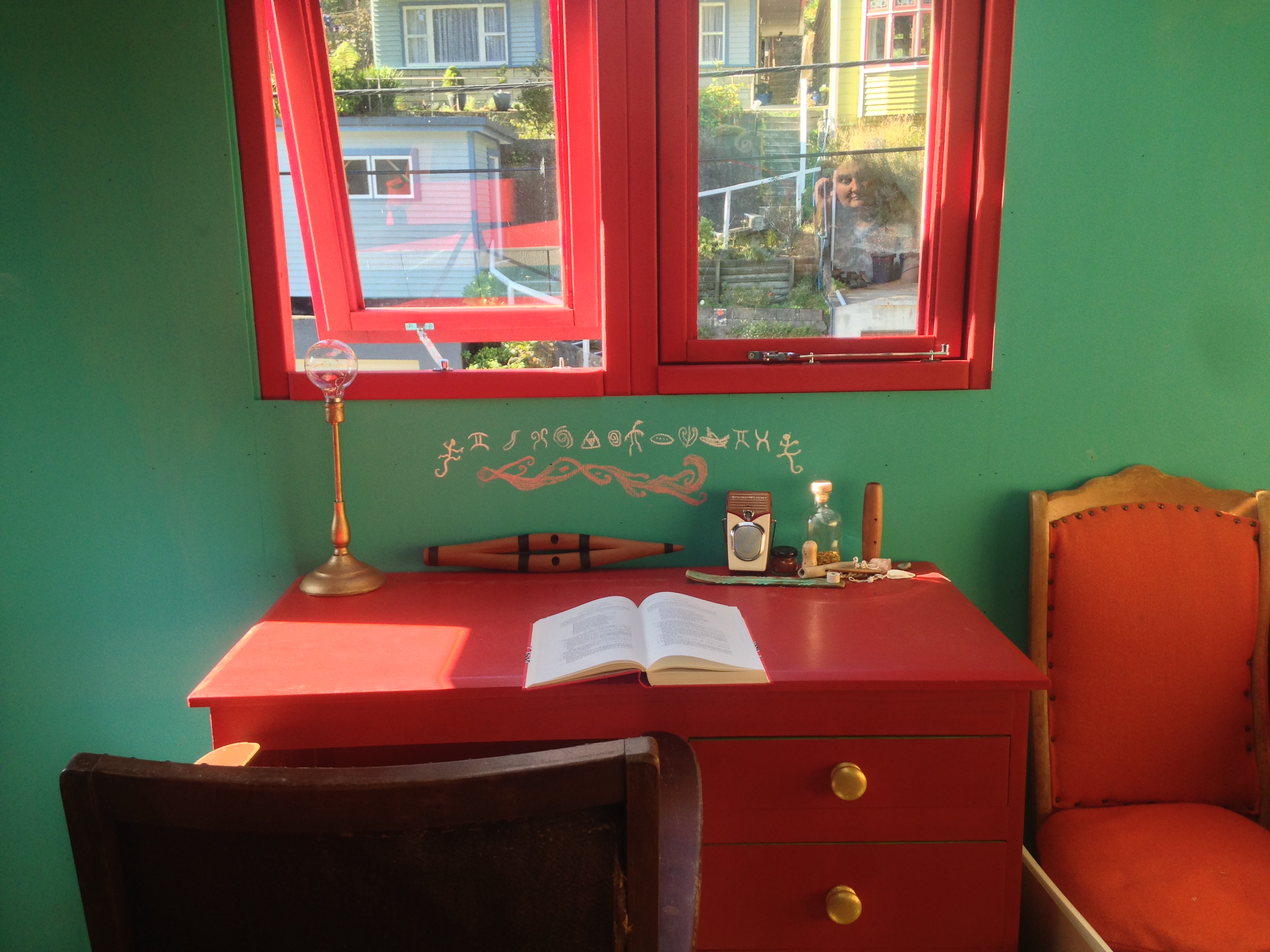 The desk in Ruby’s studio, as well as her putorino, taonga, and sketches of Kai Tahu cave art.
The desk in Ruby’s studio, as well as her putorino, taonga, and sketches of Kai Tahu cave art.
What equipment (including software) do you have in your space? Is there anything unusual, interesting or quirky about it?
I’m pretty low on the equipment side of things. In the house I have a condenser mic, a Beta 58, an interface, and I’m using REAPER as a recording software at the moment. In the studio I have a desk I painted and lots of space to spread things out and play. Te Whare Whakaaro is full of interesting weird little details which make it a beautiful space to work in. I painted the fake rug on the floor which is inspired by a cloak out the back of Te Papa with card suits on it which is a bit of a mystery piece. There’s also my desk which I’ve painted to show Aoraki mauka, the Waitaki river, and Rūaomoko under neath, who is an appropriate aqua to have represented here in Wellington! I’ve got some other special taonga on my desk including some kokowai, a koauau, a pūtorino, some Kowhai seeds, a stone from Te Wai Pounamu, and a porosity; all gifts from friends.
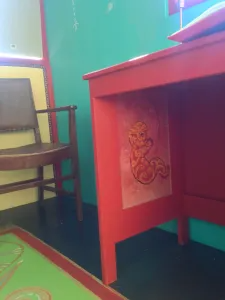 Rūaumoko hides beneath the desk.
Rūaumoko hides beneath the desk.
How have you adapted during the COVID-19 lockdown?
I’ve actually been able to be quite productive during this time. Having my own space means I can do all my noisy work away from everyone which works really well. I took on a lot of writing commissions just before lock down to replace the gigs that I’d lost which has been a really nice pace change as I can write whenever I like rather than needing to show up at a set time for a gig. I’ve been doing a lot more recording from home too rather than visiting studios to record parts for people, and it’s been great to have the opportunity to up skill and to borrow gear from people to be able to do so. It’s been really nice to be able to settle in for the day in my studio and get a whole lot of work down in one chunk rather than breaking it up across the week.
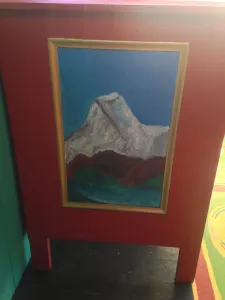 Aoraki mauka.
Aoraki mauka.
Has any special projects/songs come about as a result of the C-19 lockdown?
I’ve been able to do some great collaborations during this time with people like Al Fraser, Michelle Velvin, and Nikau Te Huki which has been awesome. I’ve been contracted to create some works that combine poetry and music to help people with their feelings of disconnection around this time which is a great opportunity for me to be able to weave together two things I love doing. My partner an I have also been playing ‘Hine e Hine’ each night for our neighbours at eight which has been a great experience. You learn a lot from playing the same song every night and trying to mix it up! It’s a great way to round off the day too.
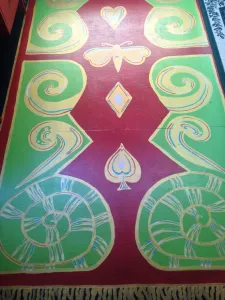 The painted rug in Te Whare Whakaaro.
The painted rug in Te Whare Whakaaro.
What are you currently working on?
I’ve been using this time to finish off work on my album of cello, taonga puoro, and environment compositions, ‘Pōneke’, which will be coming out soon! I’ve also been creating some works that are designed to be listened to on lockdowns walks which has involved a lot of environment sampling and thinking about how different spaces can host different people at different points in time, and how they overlap.
Are you doing anything special for Music Month, and if so can you tell us about it?
I’m looking forward to watching some live gigs online! We’ll be keeping up with ‘Goodnight Kiwi’ service until lockdown level three ends too, so we’ll be having teeny tiny gigs of New Zealand music each day.
Recently I was included in ōrongohau / Best New Zealand Poems 2020 with a poem called ’Six Feet For A Single, Eight Feet For A Double’. I recorded a soundtrack and recording of the poem at Braeburn studios, which is a first for Best New Zealand Poems. The poem itself is based off an old Kai Tahu moteatea, so it was lovely to be able to sing and use koauau to bring the motifs from my tūpuna out in conjunction with the words themselves.
